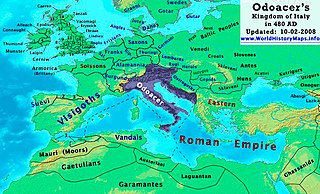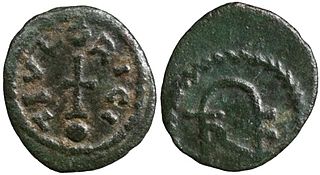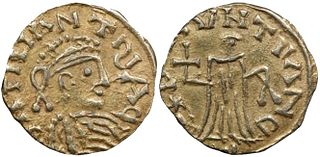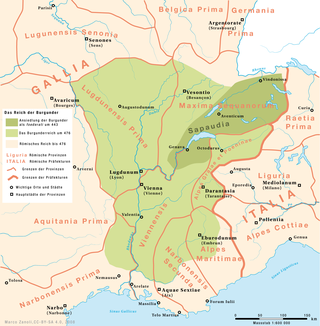
The Burgundians were an early Germanic tribe or group of tribes. They appeared east in the middle Rhine region in the third century AD, and were later moved west into the Roman Empire, in Gaul. In the first and second centuries AD they, or a people with the same name, were mentioned by Roman writers living west of the Vistula river in the region of Germania which is now part of Poland.

Year 480 (CDLXXX) was a leap year starting on Tuesday of the Julian calendar. At the time, it was known as the Year of the Consulship of Basilius without colleague. The denomination 480 for this year has been used since the early medieval period, when the Anno Domini calendar era became the prevalent method in Europe for naming years.
The 480s decade ran from January 1, 480, to December 31, 489.

Year 473 (CDLXXIII) was a common year starting on Monday of the Julian calendar. At the time, it was known as the Year of the Consulship of Leo without colleague. The denomination 473 for this year has been used since the early medieval period, when the Anno Domini calendar era became the prevalent method in Europe for naming years.

Theuderic I was the Merovingian king of Metz, Rheims, or Austrasia—as it is variously called—from 511 to 534.

Clotilde, is a saint and was a Queen of the Franks.

Chlothar I, sometime called "the Old", also anglicised as Clotaire, was a king of the Franks of the Merovingian dynasty and one of the four sons of Clovis I.

Gundobad was King of the Burgundians (473–516), succeeding his father Gundioc of Burgundy. Previous to this, he had been a patrician of the moribund Western Roman Empire in 472–473, three years before its collapse, succeeding his uncle Ricimer. He is perhaps best known today as the probable issuer of the Lex Burgundionum legal codes, which synthesized Roman law with ancient Germanic customs. He was the husband of Caretene.

Saint Gontrand, also called Gontran, Gontram, Guntram, Gunthram, Gunthchramn, and Guntramnus, was the king of the Kingdom of Orléans from AD 561 to AD 592. He was the third-eldest and second-eldest-surviving son of Chlothar I and Ingunda. On his father's death in 561, he became king of a fourth of the Kingdom of the Franks, and made his capital at Orléans. The name "Gontrand" denotes "War Raven".
Kingdom of Burgundy was a name given to various states located in Western Europe during the Middle Ages. The historical Burgundy correlates with the border area of France and Switzerland and includes the major modern cities of Geneva and Lyon.
Godomar II, son of king Gundobad, was king of Burgundy. He ruled Burgundy after the death of Sigismund, his elder brother, in 524 until 534.
Gondioc, also called Gunderic and Gundowech, was a King of the Burgundians, succeeding his putative father Gunther in 436.
Godegisel was a Burgundian sub-king and son of the Burgundian king Gondioc.
Chilperic II was the King of Burgundy from 473 until his death. Before that he co-ruled with his father Gondioc beginning in 463. He began his reign in 473 after the partition of Burgundy with his younger brothers Godegisel, Gundobad, and Godomar; he ruled from Valentia Julia (Valence) and his brothers ruled respectively from Geneva, Vienne, and Lyon.
Chilperic I was the King of Burgundy from 473 until his death. He succeeded his brother Gundioch and co-ruled with his nephews Godomar, Gundobad, Chilperic II, and Godegisel.

The Kingdom of the Burgundians, or First Kingdom of Burgundy, was established by Germanic Burgundians in the Rhineland and then in eastern Gaul in the 5th century.

The Franco-Visigothic Wars were a series of wars between the Franks and the Visigoths, but it also involved the Burgundians, the Ostrogoths and the Romans. The most noteworthy war of the conflict would be the Second Franco-Visigothic War that included the famous Battle of Vouillé and resulted in Frankish annexation of most of Southern France.
Teudelinda was a Burgundian queen consort by marriage to king Godegisel. She founded a number of churches around Geneva. Teudelinda was killed at Vienne during the war between her husband and his brother, Gundobad.
This page is based on this
Wikipedia article Text is available under the
CC BY-SA 4.0 license; additional terms may apply.
Images, videos and audio are available under their respective licenses.









